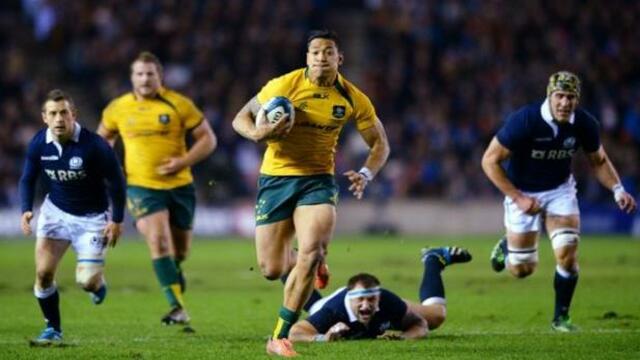Israel Folau’s 27th minute score set Australia on their way to victory against Scotland on Saturday and on the face of it, the try was simply about a missed tackle from Ryan Grant. Credit must also go to the try-scorer for the manner in which he burst through the flailing arms of the defender; Folau is a hard man to stop in full flight.
However, the real intelligence of the try was that the Wallabies fullback had picked out the loosehead prop as a specific target to run through. Quade Cooper had seen it too: a slow defender in the line, a weakness. The out-half drew his own man to the right, giving Folau those extra inches to power into, before slipping his fullback an inside pass to exploit Grant.
Learn how to exploit mismatches with Wayne Smith’s ‘Decision Making – Attack’
Israel Dagg provided us with another example of something similar during the All Blacks’ 41-33 victory against the Wallabies in October. With his team attacking from left to right, the fullback spotted Stephen Moore back on the left-hand side of a ruck and made a long, arcing run across from his starting position wide on the right, switching play to target the hooker.
Receiving the ball at pace, Dagg was able to burst outside the slower defender to set up Julian Savea for a crucial opening try. It may have seemed simply like a moment of sheer inspiration by Dagg, but it was really the result of the Crusaders man scanning the defence in search of a weak link; in this case Stephen Moore.
It’s something that divides great backs from good backs, that ability to pick out weaknesses in the opposition defence and ruthlessly exploit them. Brian O’Driscoll has made an art form of it for Ireland over the last decade, while Dan Carter can often be spotted ghosting past ‘fatties’ in the defence to set up scores for the All Blacks.
Dan Carter ‘Decision Making on Attack’ – Watch Now
It takes great composure to actually spot these opportunities on the pitch. Everybody who has played the game understands the premise of searching for slow and weak defenders, but equally they will appreciate how difficult it is to remember to constantly scan the defence during phase play.
Attacking players are very often more interested in where the ball is, and most gazes will be focused on the ruck or the ball carrier. How often are we scanning the pitch looking for space or searching for weak defenders? The best players will be doing this constantly. They operate one, two, even three phases ahead of play, calmly processing where to attack next.
If you’re lucky enough to see someone like Carter, Quade Cooper or Jonny Sexton play live in the flesh, keep a close eye on them when the action is elsewhere on the pitch. Try to see the pitch through their eyes. Notice how often they look up, across the pitch, and away from the immediate action surrounding the ball. These players are composed enough to remember to always search for space and weak points in the defence, even as play unfolds franticly.
Join Dan Carter & 18 of the world’s leading coaches & players – subscribe to The Rugby Site today
Is it an innate skill? Clearly strong natural visual ability is a huge help, but I firmly believe that these skills can be learned. Making players aware of what to look out for is a simple but effective enabler. How many fullbacks are actually searching for weak defenders when they counter attack? Are they simply running the ball back hoping something opens up? Are centres waiting patiently to spot a slow prop in the defensive line during phase play?
The All Blacks are good at exploiting weak defenders because they operate with such a mental calmness. They have worked hard at building that state of mind, and it helps with so many other aspects of their game. Over the years we have seen the Kiwis attacking injured players too, a clever ploy. If someone is clearly carrying an injury and remains on the pitch, they expertly target that defender’s channel.
Even if we can’t build the All Blacks’ coolness under pressure in our own players, we can at least help them to improve in this regard. Video analysis would certainly be an aid, highlighting ‘missed’ opportunities to take on weak defenders and simply making our players aware of what they can look out for in their next game or training session.
It can be a task shared amongst the team too. There is no requirement for the same handful of players to be the ones to spot the opportunities every time. Wingers often have the most time to scan the defence; they can communicate into their out-half and centres that there is a chance for taking a weak defender on.
Complicated attacking moves and deeply planned structures are all well and good but the game’s essence is about beating defenders. There need not always be an over-complicated starter move to achieve that. Rugby has always been a game for all body shapes and sizes, and that’s what makes it such a wonderful sport. There are mismatches to be exploited in every single game.
Once a player is aware of what to look for, they can begin to truly observe what is in front of them on the pitch. Some players excel in this area, but everyone can improve.
Which professional players stand out in this area? Is it an innate skill in your opinion? How can you improve your players’ ability to spot mismatches?












.jpg)

.jpg)







